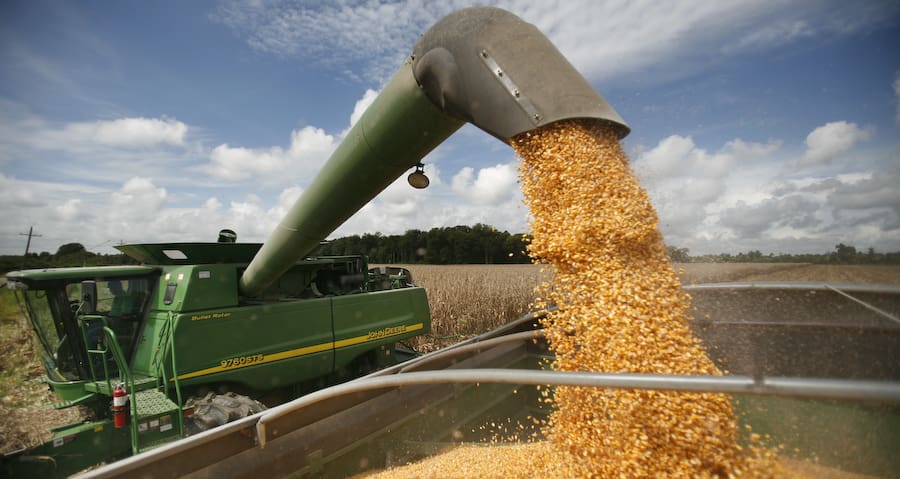
China has a growing appetite for imported grain including US corn, soybeans, wheat, sorghum and barley. Photo: Port of Greater Baton Rouge
MYSTERY surrounds the sudden suspension of operations of one of China’s primary agricultural data providers, leaving domestic and global merchants, analysts, and brokers in the dark about all things agriculture in the Middle Kingdom.
Cofeed is a Beijing-based private agricultural consultancy. It has established itself as one of the most influential and comprehensive providers of Chinese supply-and-demand information since its establishment in 2002. Officially known as Beijing TianxiaLiangchang Technology Co Ltd, the company ceased updating its website on April 29, leaving domestic and global market participants scrambling for alternative sources of trustworthy data.
According to the company website, Cofeed specialises in providing market information, value-added services, business internet solutions and e-commerce to production enterprises and traders of grain, oilseeds and stockfeed. In the past 19 years, it has reportedly built excellent relationships with governments, industry associations, professional information and research organisations both at home and abroad. Cofeed’s statistics on soybean imports, crush margins, operating rates at oilseed crushing plants, oilseed and meal inventories and regional
pricing is regarded as the most accurate and reliable information available to the market.
According to news wires, the company moved out of its Beijing office sometime last year and has been operating from a villa on the capital’s outskirts. However, it appears that local police sealed the doors to those premises on April 29 and staff cannot be reached.
Another company in the Chinese agricultural data sphere is JC Intelligence Co Ltd (JCI). It is based in Shanghai, and was also established in 2002. The company provides financial information and trade consultation services, as well as agricultural commodity data and analysis. However, the company’s head is reported to have been recently jailed, allegedly for divulging too much information about China’s corn balance sheet.
This data turmoil comes at a time of heightened focus on China, given its insatiable appetite for soybean, corn and wheat imports in recent times. China is expected to import 100 million tonnes (Mt) of soybeans in the current marketing year at a cost of around US$40 billion. That represented almost 60 per cent of global trade in soybeans.
Rising demand
Last week’s World Agricultural Supply and Demand Estimates (WASDE) report pegged Chinese corn imports at 26Mt in the current marketing year. With purchases from the US totalling almost 20Mt alone, that number still appears on the light side, despite recent cancellations of current-crop US sales.
Domestic demand for wheat has risen by more than 19pc, or 24Mt, in the 2020-21 marketing year to 150Mt. Relatively high opening stocks helped the equation, but imports are still forecast to be up by more than 95pc, or 5.12Mt to 10.50Mt. Other feedgrains such as barley and sorghum are also being sucked up in the China vacuum, especially with the recently announced search for corn substitutes in the feed grain ration. Barley imports for the 2020-21 season are forecast at 9.2Mt, with sorghum not far behind at 7.8Mt.
According to the USDA, the import milestones set in 2020-21 appear to be the new norm. Last week’s WASDE report has forecast China’s imports of soybeans, corn and wheat in the 2021-22 marketing year at 103Mt, 26Mt and 10Mt respectively. Barley imports are projected to hit 10Mt for the first time in 2021-22, and sorghum imports are also pegged at 10Mt, a mark that has been surpassed only once before.
The perceived crackdown by Beijing on the provision of agricultural data appears to support the concept that the country’s demand for grains, oilseeds and protein meals is far greater than it is currently portraying to the global marketplace. The suppression of information also comes against the backdrop of the Phase 1 trade agreement between the United States and China, and the growing political tensions that threaten to scuttle that deal.
Numbers hard to see
It has never been easy to determine exactly what is happening in China’s agricultural sector. Beijing has long been secretive regarding the country’s grain and oilseed production and import requirements; it has been accused of fabricating numbers in the past. In March of this year, China’s National Bureau of Statistics reported that it had uncovered statistical fraud stemming from data supplied by the agriculture ministry back in August 2020.
The detection of misrepresentation in the government’s agricultural statistics was revealed very quietly. It reportedly came not long after Beijing had proudly proclaimed victory over rural poverty and celebrated the surprisingly rapid recovery in the pig herd following the devastating African Swine Fever outbreak. Both achievements were apparently declared on the basis of statistical indicators supplied by the Ministry of Agriculture and Rural Affairs.
China’s rhetoric and actions in global agricultural markets have often been contradictory. They are masters at working the global trade floor. Maybe this time, a confluence of circumstances such as low stocks, COVID-19, African Swine Fever, floods, high prices and domestic production issues have them reeling. Muffling the flow of market information suggests that they are intent on clouding the true domestic picture and keeping global markets speculating.

I want more news about China. China is my neighbor country, it is well developed and helping country. I love to hear more about China.